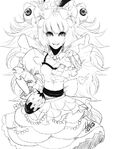(→Music) |
(Adding categories) |
||
| Line 73: | Line 73: | ||
[[Category:Nariyuki Quest Characters]] |
[[Category:Nariyuki Quest Characters]] |
||
[[Category:Other]] |
[[Category:Other]] |
||
| + | [[Category:Clones]] |
||
Revision as of 14:35, 7 August 2018
Sylvie Paula Paula (シルヴィ・ポーラ・ポーラ) is a new character in The King of Fighters XIV. She is voiced by Mio.
Story
One of the last remnants of NESTS, Sylvie was considered useless by the secret society until the day she demonstrated her electromagnetic powers. After the cartel's collapse, she was scouted by future employer Antonov during an underground fighting event and was later hired along with Mian and Kukri as part of his Official Invitation Team.
Personality
Sylvie is a cheerful and innocent, yet strange and childlike individual. It has been suggested that her personality has been affected as a result of her powers or the experiments performed on her to bring about said abilities. She considers the objects she wears and a voice inside her head as her "friends". She can take matters seriously and is trying to overcome her past trauma. She fears her former NESTS seniors like Angel, afraid of being called "useless" or "junk", and feels a certain kinship with fellow NESTS experiment Kula Diamond.
Powers
- Electrokinesis - Sylvie can control electricity.
- Levitation - Using her electrokinesis, Sylvie can propel herself across the ground and into the air.
Skills
Fighting Style
Sylvie's fighting style is heavily centered around electrical manipulation mixed with her own odd improvised form of martial arts.
Music
- Venator Ballare - The King of Fighters XIV
- Venator Ballare ~SNK Heroines SYLVIE Edit~ - SNK Heroines: Tag Team Frenzy
Game Appearances
- The King of Fighters XIV (also in Little Red Hiding Hood DLC Costume)
- SNK Heroines: Tag Team Frenzy
See also
Sprites
Gallery
Trivia
- She is the second character from the KOF franchise to have more than one last name, the first one being Wolfgang Krauser, whose full name is Wolfgang Krauser von Stroheim.
- Her appearence is similar to that of the Japanese singer Kyary Pamyu Pamyu.
- Her outfit resembles the Diablada from a Peruvian, Bolivian, and Chilean celebration named Fiesta de La Tirana.






